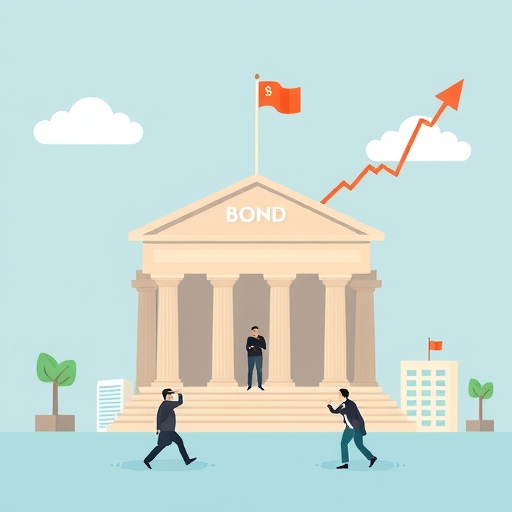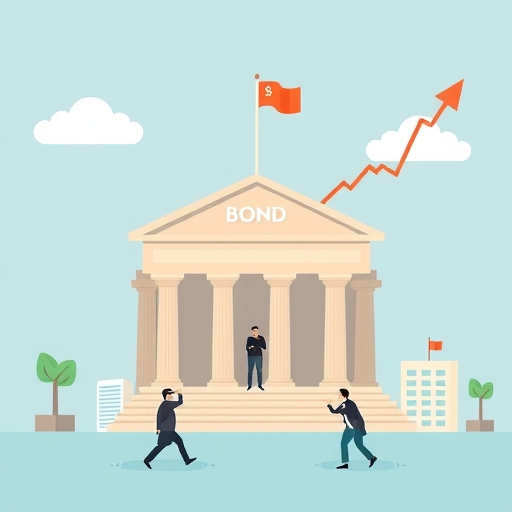Corporate Bond ETFs: Unlocking Income and Diversification in a Changing Rate Environment
Are you looking for ways to generate steady income and strengthen your investment portfolio, especially as the financial landscape shifts? As the Federal Reserve begins to adjust interest rates and an economic soft landing appears increasingly likely, many income-seeking investors are turning their attention to corporate bond Exchange-Traded Funds (ETFs). These funds offer a compelling alternative to what were once high-yielding money market funds and short-term Treasury securities, whose returns are now beginning to cool alongside inflation.
This comprehensive guide will walk you through the world of corporate bond ETFs. We will define what they are, explore the current market conditions that make them particularly appealing, highlight their core benefits and risks, compare them to traditional Treasury bonds, and provide guidance on how to choose the right ETF for your investment strategy. Our goal is to empower you with the knowledge to make informed decisions for your financial future.
What Are Corporate Bond ETFs and Why Invest Now?
At its core, a corporate bond ETF is an exchange-traded fund that invests in a diversified basket of debt securities issued by companies. Think of it this way: instead of you buying individual bonds from various corporations, which can be complex and expensive, an ETF allows you to own a small piece of many different bonds through a single share. This provides accessible exposure to the vast corporate bond market without requiring extensive expertise or substantial capital.
These ETFs can be passively managed, meaning they simply aim to track a specific bond index, or actively managed, where a fund manager tries to outperform an index. They offer remarkable flexibility, allowing investors to target specific sectors (like financials or industrials), different levels of credit quality (ranging from investment-grade to high-yield, often called ‘junk bonds’), or various maturities (short-term, intermediate-term, or long-term bonds). This versatility allows you to tailor your exposure to fit your specific investment goals and risk tolerance. This versatility allows investors to precisely tailor their exposure to fit specific investment goals and risk tolerance. For instance, you can target bonds based on their:
- Sector focus, such as financials, industrials, or utilities, allowing for industry-specific exposure.
- Credit quality, ranging from the stability of investment-grade bonds to the higher yield but greater risk of high-yield or ‘junk’ bonds.
- Maturity profiles, choosing between short-term, intermediate-term, or long-term bonds to manage interest rate sensitivity.
Choosing between passive and active management depends on your belief in a manager’s ability to outperform the market after fees, versus the desire for low-cost, broad market exposure.
| Feature | Passively Managed ETF | Actively Managed ETF |
|---|---|---|
| Objective | Track a specific bond index | Outperform a specific bond index |
| Management Style | Rules-based, minimal human intervention | Discretionary, human analysis and decision-making |
| Expense Ratio | Generally lower | Generally higher |
| Flexibility | Limited to index components | Can adapt to market changes, select specific bonds |
So, why are these funds particularly attractive right now, looking into 2024 and 2025? As the Federal Reserve contemplates lowering interest rates and economists anticipate an economic soft landing (meaning the economy slows down without entering a severe recession), corporate bond ETFs are becoming increasingly appealing for income investors. As inflation cools, the yields offered by traditionally safe options like money market funds and short-term Treasury securities begin to decline. In this falling rate environment, corporate bond ETFs can potentially offer higher yields and more attractive long-term returns compared to other fixed-income options.
However, a word of caution is necessary: if economic conditions were to deteriorate into a full-blown recession, high-yield bond ETFs could face significant challenges due to increased default risk among less stable companies. For cautious investors, focusing on investment-grade corporate bond ETFs, which hold bonds from more financially sound companies, generally offers a safer path.
The Core Benefits and Risks of Corporate Bond ETFs
Like any investment, corporate bond ETFs come with their own set of advantages and disadvantages. Understanding both sides is crucial for making a balanced decision. Let’s first explore the compelling benefits they offer:
- Diversification: Perhaps the most significant advantage is that these ETFs provide exposure to a broad basket of bonds. This reduces the specific risk associated with any single company defaulting on its debt. If one company struggles, its impact on your overall portfolio is minimized because you hold many other bonds.
- Liquidity: Unlike individual bonds, which can sometimes be difficult to buy or sell quickly, ETFs are traded on major stock exchanges throughout the day. This offers investors the flexibility to buy and sell shares intraday, much like stocks, providing excellent liquidity.
- Accessibility: For many retail investors, buying individual corporate bonds can be daunting, requiring substantial capital and expertise. ETFs lower this barrier to entry significantly, allowing you to gain exposure to the corporate bond market with a relatively small investment.
- Lower Costs: Compared to traditional bond mutual funds, bond ETFs typically have lower management fees, also known as expense ratios. This means more of your investment capital works for you, rather than going towards fees.
- Income Generation: Generally, corporate bond ETFs aim to provide regular income through interest payments (coupons) from the underlying bonds. They often offer higher yields and potentially better long-term returns compared to government bonds, compensating investors for taking on additional credit risk.
However, it’s equally important to be aware of the potential risks:
- Interest Rate Risk: This is a fundamental risk for all fixed-income investments. When market interest rates rise, the prices of existing bonds (and thus the value of bond ETFs) typically fall. Why? Because newly issued bonds will offer higher yields, making older, lower-yielding bonds less attractive.
- Credit Risk: This is the risk that the company issuing the bond (the issuer) will be unable to make its interest payments or repay the principal amount. This risk is particularly higher for high-yield bonds, which are issued by companies with lower credit ratings.
- Liquidity Risk: While the ETF itself is highly liquid (you can trade its shares easily), the underlying individual bonds it holds may not always be as liquid, especially during periods of market stress. This can sometimes affect the ETF’s bid-ask spreads and how closely its market price tracks its underlying asset value.
- Market Volatility: Like stocks, ETF prices can fluctuate throughout the trading day based on overall market sentiment, economic news, or changes in interest rate expectations. This means the ETF’s market price can sometimes deviate slightly from the combined value of its underlying bonds (its Net Asset Value, or NAV).
Corporate Bonds vs. Treasury Bonds: A Strategic Comparison
When considering fixed-income investments, two major categories often come up: corporate bonds and Treasury bonds. While both represent debt instruments, they differ significantly in terms of issuer, risk, and potential returns. Understanding these differences is key to building a balanced portfolio.
Corporate bonds are essentially loans made to companies. When you buy a corporate bond, you are lending money to a corporation, which then agrees to pay you regular interest payments (called “coupons”) over a set period and return your original investment (the “principal”) at the bond’s maturity date. Companies issue these bonds to raise capital for various purposes, such as expanding operations, funding new projects, or refinancing existing debt. Because companies can, in theory, default on their obligations, corporate bonds generally offer higher yields than government bonds to compensate investors for this added credit risk.
On the other hand, Treasury bonds (or U.S. Treasury securities) are debt instruments issued by the U.S. government. These are widely considered among the safest investments in the world because they are backed by the “full faith and credit” of the U.S. government, meaning the probability of default is extremely low. Due to their superior safety and typically higher liquidity, Treasury bonds usually offer lower yields compared to corporate bonds. They serve as a benchmark for risk-free rates in the financial markets.
Here’s a simple comparison to highlight the key differences:
| Feature | Corporate Bonds | Treasury Bonds |
|---|---|---|
| Issuer | Private Companies | U.S. Government |
| Primary Purpose | Raise capital for business operations | Finance government spending |
| Yield | Generally higher | Generally lower |
| Credit Risk | Present (risk of company default) | Virtually none (backed by U.S. government) |
| Liquidity | Good, but can vary by issue | Excellent (highly liquid market) |
| Suitability | For investors seeking higher income willing to accept more risk | For investors prioritizing safety and stability |
For investors, the choice between corporate and Treasury bonds, or a combination thereof, often comes down to a trade-off between yield and safety. A well-diversified portfolio might include both, balancing the higher income potential of corporate bonds with the stability and safety of Treasury bonds. For example, some investors might use ETFs like the iShares iBoxx $ Invmt Grade Corp Bd ETF (LQD) for corporate exposure and the iShares 7-10 Year Treasury Bond ETF (IEF) for Treasury exposure to create a balanced fixed-income allocation.
Navigating the Market: Choosing the Right Corporate Bond ETF for Your Portfolio
With a growing number of corporate bond ETFs available, how do you choose the right one for your portfolio? It’s not just about picking the highest yield; it’s about aligning the ETF’s characteristics with your personal investment objectives and risk tolerance. Let’s explore the crucial factors to consider:
Let’s explore the crucial factors to consider:
First, consider the issuer type. While this article focuses on corporate bonds, remember that government bonds (like U.S. Treasuries) generally offer lower risk but also lower yields. If you’re looking specifically for corporate exposure, you’ll then delve into the specifics of those issuers.
Second, and perhaps most importantly, is credit rating. This tells you about the creditworthiness of the companies whose bonds the ETF holds. Ratings typically range from AAA (highest quality, lowest risk) down to C or D (indicating high-yield or junk status, higher risk, but higher potential yield). Bonds rated BBB- or above are considered investment-grade, meaning they are deemed to have a lower risk of default. Bonds rated BB+ and below are categorized as high-yield (or “junk bonds”), carrying a higher risk of default but offering potentially higher returns to compensate for that risk. Your choice here depends directly on how much risk you’re willing to take for potentially higher income. To clarify the distinction between these categories:
- Investment-grade bonds are issued by financially strong companies with a low perceived risk of default, offering stability and moderate returns.
- High-yield bonds, also known as ‘junk bonds’, are issued by companies with lower credit ratings, implying a higher risk of default but typically offering higher interest rates to compensate investors for this increased risk.
- Understanding this spectrum is essential as it directly impacts both the potential income and the risk profile of your bond ETF.
These ratings provide a quick reference for the perceived default risk of the underlying bonds within an ETF, with higher ratings indicating lower risk.
| Rating Agency | Investment-Grade (Examples) | High-Yield (Examples) |
|---|---|---|
| S&P Global Ratings | AAA, AA, A, BBB | BB, B, CCC, CC, C, D |
| Moody’s | Aaa, Aa, A, Baa | Ba, B, Caa, Ca, C |
| Fitch Ratings | AAA, AA, A, BBB | BB, B, CCC, CC, C, D |
Third, think about maturity. This refers to the average length of time until the bonds within the ETF mature. Short-term bond ETFs (e.g., 1-5 years) are generally less risky than long-term bond ETFs (e.g., 10+ years) because they are less sensitive to changes in interest rates. When rates rise, long-term bonds typically experience larger price drops than short-term bonds. For example, the Vanguard Short-Term Corporate Bond ETF (VCSH) would have less interest rate risk than the Vanguard Intermediate-Term Corporate Bond ETF (VCIT).
Your choice of maturity profile should align with your investment horizon and your outlook on future interest rate movements, as longer maturities are more sensitive to rate changes.
| Maturity Profile | Typical Duration | Interest Rate Sensitivity | Potential Yield |
|---|---|---|---|
| Short-Term | 1-5 years | Lower | Lower |
| Intermediate-Term | 5-10 years | Medium | Medium |
| Long-Term | 10+ years | Higher | Higher |
Finally, consider diversification. Beyond just the number of bonds in an ETF, look at how diversified the fund is across different maturities, credit ratings, and even sectors or regions. A well-diversified ETF can help balance risk and return, preventing overexposure to any single factor.
Several leading providers offer a wide range of corporate bond ETFs. Firms like Vanguard and iShares (BlackRock) are well-known for their broad market funds. For instance, LQD from iShares focuses on investment-grade corporate bonds. More specialized offerings have also emerged, such as those from BondBloxx Investment Management Corporation. BondBloxx offers precise exposure to specific credit rating categories (e.g., BBB, BB, B, CCC rated bonds) and even high-yield sector-specific ETFs. This allows investors to fine-tune their exposure, for example, by investing specifically in BBB-rated bonds (using ETFs like BBBS or BBBL) or targeting specific high-yield sectors like Consumer Cyclicals or Industrials.
Integrating Bond ETFs into Your Diversified Investment Strategy
How can corporate bond ETFs fit into your broader investment plan? For many investors, bonds, including corporate bond ETFs, serve as a crucial complement to equity holdings (stocks). While stocks offer the potential for higher long-term growth, they also come with greater volatility. Bonds, on the other hand, are generally considered lower risk and can help to reduce the overall volatility of a portfolio, especially during stock market downturns.
Think of it as balancing your investment seesaw. When stocks are on one side, offering exciting growth but also big swings, bonds can sit on the other, providing stability and steady income. Historically, diversified portfolios that include both bonds and equities have exhibited lower volatility than portfolios composed solely of stocks. This balance can be particularly beneficial as you approach retirement or if you have a lower risk appetite.
Another important aspect of bonds is their role in a company’s financial structure. In the event of a company’s bankruptcy, bondholders (those who own the company’s debt) typically have priority over shareholders (those who own the company’s stock) when it comes to claiming assets. This provides an additional layer of safety for bond investments compared to equity investments. This prioritization offers a significant advantage to bondholders in distressed financial scenarios. Key aspects of this include:
- Claim Priority: Bondholders are typically paid before shareholders in the event of liquidation, receiving proceeds from asset sales first.
- Fixed Income Stream: Bonds provide a predictable stream of interest payments, which can offer stability to a portfolio regardless of stock market fluctuations.
- Capital Preservation: Compared to equities, bonds generally aim to preserve the initial capital investment, making them a cornerstone for conservative portfolio allocations.
To integrate corporate bond ETFs effectively, consider your overall investment horizon and how much risk you are comfortable taking. If you have a long time horizon, you might tolerate a higher percentage of equities, but still use bond ETFs to temper volatility. If you’re closer to retirement, a larger allocation to bond ETFs, particularly investment-grade ones, could help preserve capital and generate consistent income. By strategically blending corporate bond ETFs with other asset classes, you can build a more resilient portfolio designed for long-term wealth building and consistent income generation.
Ultimately, the decision to invest in corporate bond ETFs should align with your personal financial goals and understanding of the associated risks and rewards. They are powerful tools, but like any tool, their effectiveness depends on how wisely they are used.
Conclusion
Corporate bond ETFs represent a powerful and accessible tool for investors aiming to generate consistent income and diversify their portfolios, especially in the evolving interest rate environment of 2024 and 2025. We’ve explored how these funds offer diversified exposure to corporate debt, their advantages in terms of liquidity and cost-efficiency, and their potential to deliver attractive yields as alternatives to other fixed-income options.
While offering significant benefits, understanding their inherent risks, particularly credit risk and interest rate sensitivity, is paramount. By carefully considering factors such as credit quality (choosing between investment-grade and high-yield) and bond maturity, and by balancing them with the safety of Treasury bonds, investors can construct a robust fixed-income allocation that contributes significantly to achieving their financial goals.
Remember, the information provided in this article is for educational purposes only and should not be considered direct financial advice. Always consult with a qualified financial professional before making any investment decisions, ensuring they align with your individual circumstances and risk tolerance.
Frequently Asked Questions (FAQ)
Q: What is the main difference between an investment-grade corporate bond ETF and a high-yield corporate bond ETF?
A: An investment-grade corporate bond ETF invests in bonds from companies with strong financial health and a low risk of default, typically offering lower yields. A high-yield corporate bond ETF, conversely, invests in bonds from companies with lower credit ratings, carrying a higher risk of default but compensating investors with potentially higher yields.
Q: How do corporate bond ETFs provide income to investors?
A: Corporate bond ETFs generate income primarily through the interest payments (coupons) received from the underlying bonds they hold. These interest payments are then typically distributed to ETF shareholders as regular dividends, often on a monthly or quarterly basis.
Q: Are corporate bond ETFs suitable for all investors?
A: Corporate bond ETFs can be suitable for investors seeking income and diversification, but their suitability depends on individual financial goals and risk tolerance. While generally less volatile than stocks, they still carry interest rate risk and credit risk. Investors should assess their comfort level with these risks before investing and consider consulting a financial advisor.



No responses yet